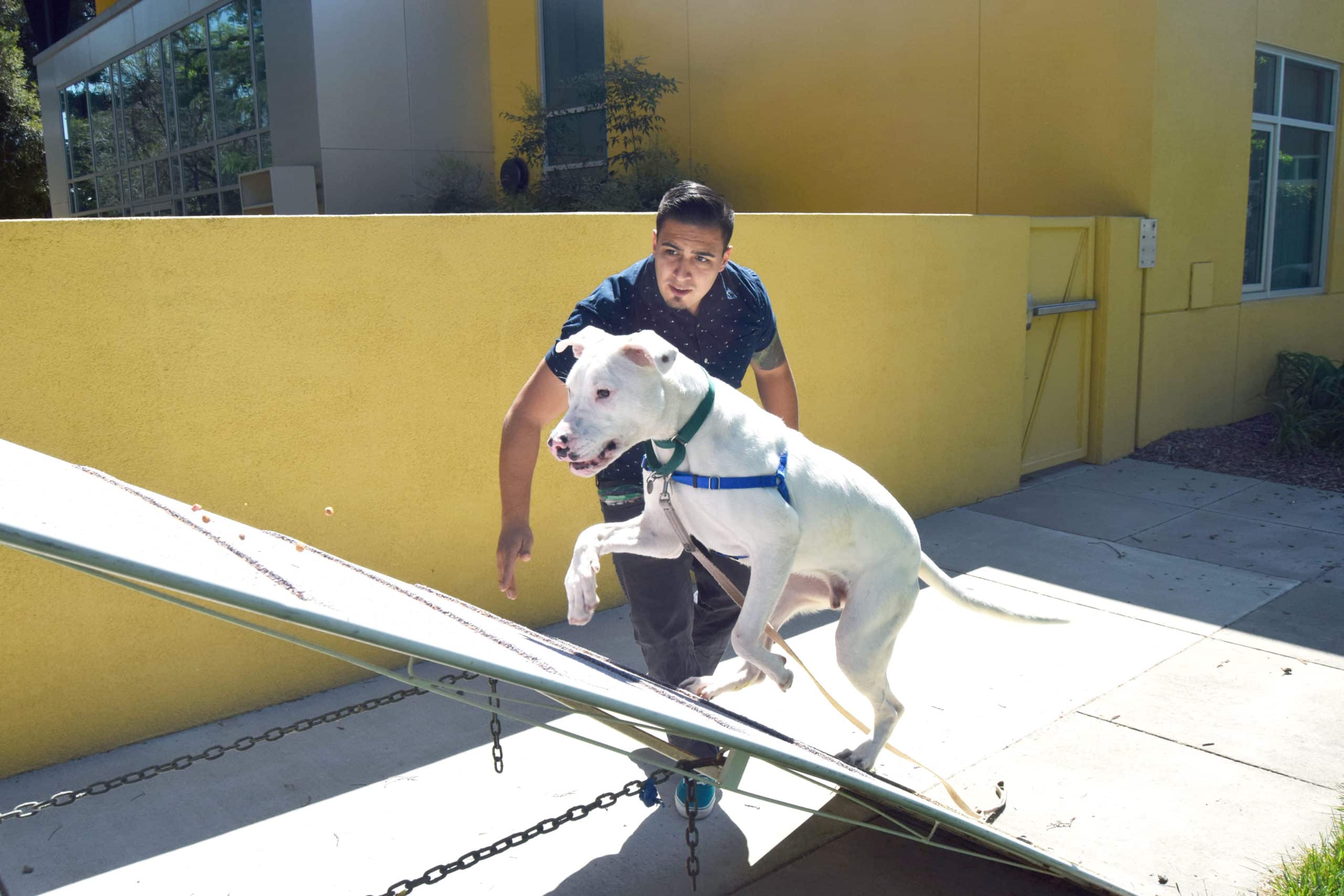
Why is a dog fearful? There are a variety of reasons that could contribute to a dog that is shy or fearful. It could be a combination of the following:
- Genetics (inherited from parents)
- Physical abuse, significant trauma, or neglect
- Lack of socialization as a puppy
What does a fearful dog look like?
- Avoiding eye contact
- Submissively urinating
- Showing their belly
- Freezing/stopping
- Barking/growling
- Lowering their head
- Flattening their ears
- Tucking their tail
- Panting/drooling
- Trembling/pacing
- Trying to run away
First Days Home with Your Dog
Avoid trying to put too much pressure on the dog. The best and most effective thing you can do is just let the dog get used to their new surroundings. Keep interactions low key and let the dog set the pace as regards when and how close he approaches you. As the dog starts to relax they’ll probably start feeling brave enough to investigate things and get a bit nearer to you. One of the keys to working with a fearful dog is making sure the dog’s day-to-day environment is relatively stress-free. Chaotic households are not ideal for scared-y dogs.
Hand Feeding
In the early days, hand feeding will go a long way towards strengthening your dog’s relationship with you and the other people in your home. Hand feeding doesn’t necessarily mean that the dog has to eat the food directly out of your hand. It simply means that the food has come from your hand. If your dog is relaxed and comfortable eating from your hand, then you can start there. But, if they are cautiously stretching over to take the food from your hand and then withdrawing as quickly as possible, then they are not ready to eat out of your hand. Try gently tossing or dropping handfuls of food near your dog. In extreme cases you might have to drop a handful of food for your dog and then back away and get out of sight so that your dog feels comfortable enough to eat. Once they’ve eaten what you dropped you would quietly return and drop another handful. Even if time only permits you to
divide your dog’s food into three to four portions that you hand feed them, it is still a worthwhile exercise — it really can make a huge difference in no time at all.
Meeting Visitors
Your dog should be your priority when meeting visitors. If you don’t have the time or attention to ensure your dog’s comfort while visitors are around, arrange for your dog to be comfortably separated in another area for the duration of the visit. It is okay for your dog to not meet every single visitor to your home. With some dogs this process can be slow (several weeks or months), while other dogs can get used to it quite quickly. The key is to never push your dog too fast or force them to interact with new people. Let the dog set the pace and it will be best for everyone.
- Before visitors even arrive, confine your dog somewhere they will be comfortable (a room with the door closed, their kennel, the backyard, etc).
- If you receive unexpected visitors, don’t answer the door until you’ve situated your dog in this comfortable space.
- Once visitors are settled, make sure they understand the importance of resisting the need to reach out, approach, or stare at your fearful dog.
- Make sure you have a supply of really tasty treats with you. Small pieces of hot dog/cheese/boiled chicken in a bait bag or fanny pack are great for this.
- As long as your dog isn’t distressed, bring them into the room on-leash, keeping a safe, comfortable distance from the visitors. Chat with your visitors as normal and while doing this
periodically feed your dog treats. - If your dog won’t take the treats, then they are too overwhelmed.
- Walk them out of the room and see if they’re comfortable enough to take treats while hearing visitors’ voice from the hallway. Reinforce your dog a couple times for hearing visitors and then separate your dog again in their comfortable space.
- You might have to repeatedly do this every time there are visitors, before your dog is ready to attempt entering the room the visitors are in again.
Comforting a Frightened Dog
A common misconception is that a dog will choose to feel fear in order to gain its owner’s attention. Comforting a frightened dog will result in one of two things — it’ll either have no effect on your dog, OR it might help a little bit. The best thing you can do is get your dog out of the scary situation as calmly and quickly as possible. Forcing a scared dog to face their fears is a recipe for disaster and can actually serve to make their fears worse.
Myth: Don’t comfort a frightened dog because it will only reinforce the dog’s fear.
Early Warning Systems Should Never Be Ignored or Punished
It is really important when working with a fearful dog to pay attention to what they’re trying to tell you. Dogs have a fight or flight response. A dog’s first choice is flight. They will try to avoid or run away from a scary situation. If they feel trapped or cornered, they now only have the fight response. They may try to warn the threat with a growl, lunge, or bark.
Unfortunately, people routinely punish their dog for these warning signals. A dog with a history of being punished for warning signals will stop using these signals and instead resort to biting. Don’t punish their warning signals. Respect their warning signals. Spring in to action and change the environment ASAP.
Additional Resources on Fearful Dogs
- Fearfuldogs.com — a wealth of information plus helpful links and videos
- The Cautious Canine: How to Help Dogs Conquer Their Fears by Patricia B. McConnell, Black Earth, WI: Dogs Best Friend, 2005
- Help for Your Fearful Dog: A Step-by-step Guide to Helping Your Dog Conquer His Fears by Nicole Wilde, Santa Clarita, CA: Phantom Pub., 2006
- The Culture Clash by Jean Donaldson, Berkeley, CA: James & Kenneth Publishers, 2005



